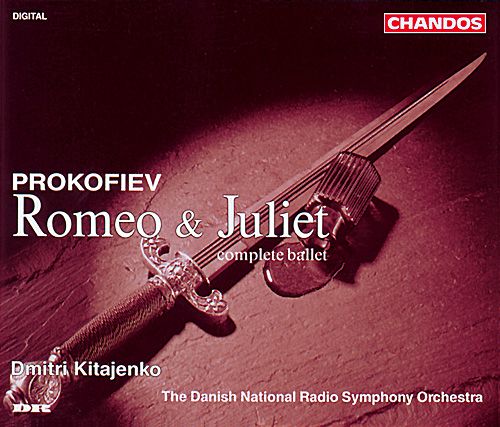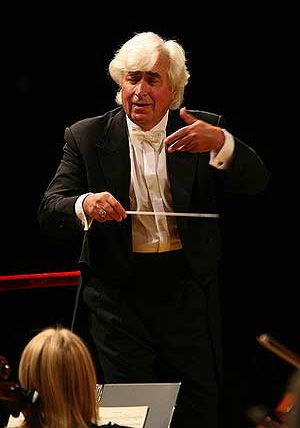wimpel69
11-27-2014, 03:45 PM
EAC-FLAC link below. This is my own rip. Complete artwork,
LOG and CUE files included. Do not share. Buy the original!
Please leave a "Like" or "Thank you" if you enjoyed this!
In the early- and mid-twentieth century, the three major Tchaikovsky ballets -- Swan Lake, The Sleeping Beauty,
and The Nutcracker -- were viewed as the three greatest full-length ballets. Not surprisingly, they were also more
popular by wide margins than all other works in the genre. By the latter quarter of the century, however, Prokofiev's
Romeo and Juliet had entered the trio's select company and remains exceedingly popular today. Some have even
asserted it is the greatest of full-length ballets. Certainly, it is one of Prokofiev's supreme masterpieces and, via the three
suites extracted from it, among his most often-played music.
His previous ballets had been shorter and more pungent, like Chout, Op. 21 (1915-1920), and
Le Pas d'Acier, Op. 41 (1925), which created a bit of a stir in Paris when it premiered. Both, along
with The Prodigal Son (1929), were composed for Sergei Diaghilev's Ballets Russes. Romeo and Juliet was
thus his first attempt at writing a full-length ballet, and while he would have further successes in the genre,
most notably with Cinderella, no other stage work of his would quite approach it in popularity.
Prokofiev's Romeo and Juliet, based on Shakespeare's play, consists of four acts and ten scenes, within
which are 52 separate dance numbers. The work opens with a six-note motif that appears throughout the
ballet. This same theme, cut to four notes, opens the composer's Symphony-Concerto for Cello and Orchestra
(1950-1952) and appears elsewhere in its first movement. There are many famous melodies in Romeo and Juliet,
foremost among which is probably the march-like theme that appears in No. 13, "Dance of the Knights."
This music symbolizes the strife between the opposing families. A variant of it is played in the next number,
"Juliet's Variation," where its character changes from the austere malevolence in No. 13 to innocence and
playfulness.
Another important and immensely popular melody is the love theme of Romeo and Juliet. It is a soaring
melody in an arch-like pattern that exudes warmth and yearning, passion and grace. But there are many
other memorable themes, including the joyous, rhythmic one in No. 12, "Masks," as well as the two in No. 22,
"Folk Dance." Perhaps the most profound creation in the ballet, however, is the dark and tragic theme appearing
in No. 51, "Juliet's Funeral," whose arch-like pattern is similar to that of the love theme.
Prokofiev also quotes from his own Classical Symphony here (No. 18 "Gavotte"), using music from the third
movement Gavotte. It is not for want of thematic material that he resorts to this reference, but to show irony:
this post-Renaissance French dance is as much miscast here as the two teenage lovers who are caught up in
an unforgiving adult world. Romeo and Juliet lasts about two-and-one half hours in a typical performance.
It was premiered in Brno, Czechoslovakia, on December 30, 1938.
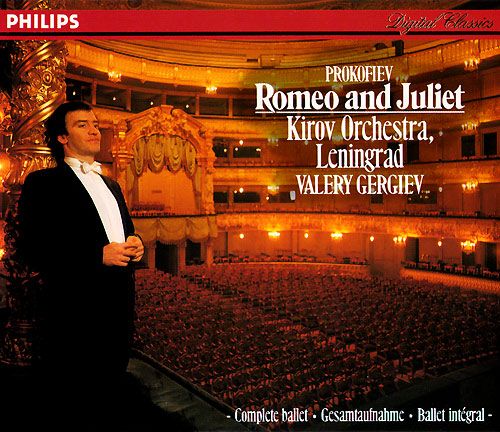
Music Composed by
Sergei Prokofiev
Played by the
Kirov Orchestra, Leningrad
Conducted by
Valery Gergiev
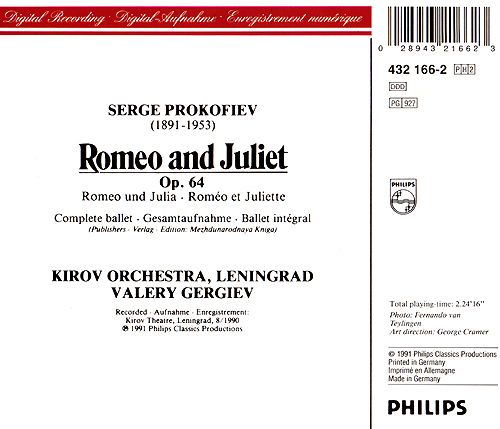
"Valery Gergiev has in common with Bernstein that his charisma was recognized the moment
he stepped on the podium, and it's no wonder that he became a superstar in the post-Soviet era.
Having just reviewed Gergiev's recent Romeo and Juliet with the London Sym., I returned to this
early version with the Kirov Orch. from 1990. Both are superlative, but the younger Gergiev
had a more natural way with the score and was less prone to making a show piece of every
number. Playing Prokofiev's complete ballet score was rare in the West. I attended a riveting
performance by Gergiev and the Kirov, and the program notes said that the complete score
had never before been played in Carnegie Hall.
What stands out about this reading is that Gergiev, an extremely intelligent thinker about the
long line, handles the rise and fall of the ballet so that it doesn't peak too early, doesn't turn
cloying, and never exhausts the listener (he's spoken to all these points in interviews, although
the subject was Mahler). Each number is exciting, but it takes its place in a very satisfying
overall scheme. No other reading that I know of is so successful on that front, not even
Gergiev's remake. Prokofiev's music is scintillating, and it never lets up, but Gergiev
balances the lesser climaxes with the greater ones. I apologize for sounding so abstract
when the score is luscious, romantic, and swooningly gorgeous. Yet I think anyone who
listens for it will notice how beautifully Gergiev has structured the performance. It's
welcome in both his readings that he avoids vulgarity and luridness, always a temptation
in this crowd-pleasing music.
On its own, this is an early indication that Gergiev deserves his superstar status."
Amazon Reviewer
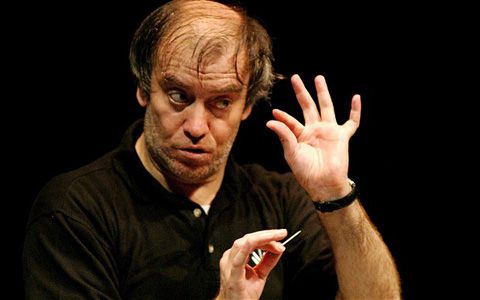
Download Link - https://mega.co.nz/#!zIZBCIDI!yOgb_uGh55gxmoLE-525hSZqim6iS7s5jt4SqV-BoOc
Source: Philips CDs, 1991 (my rip!)
Format: FLAC(RAR), DDD Stereo, Level: -5
File Size: 569 MB (incl. artwork, booklet, log & cue)
Enjoy! Don't share! Buy the origina! Please leave a "Like" or "Thank you" if you enjoyed this! :)
LOG and CUE files included. Do not share. Buy the original!
Please leave a "Like" or "Thank you" if you enjoyed this!
In the early- and mid-twentieth century, the three major Tchaikovsky ballets -- Swan Lake, The Sleeping Beauty,
and The Nutcracker -- were viewed as the three greatest full-length ballets. Not surprisingly, they were also more
popular by wide margins than all other works in the genre. By the latter quarter of the century, however, Prokofiev's
Romeo and Juliet had entered the trio's select company and remains exceedingly popular today. Some have even
asserted it is the greatest of full-length ballets. Certainly, it is one of Prokofiev's supreme masterpieces and, via the three
suites extracted from it, among his most often-played music.
His previous ballets had been shorter and more pungent, like Chout, Op. 21 (1915-1920), and
Le Pas d'Acier, Op. 41 (1925), which created a bit of a stir in Paris when it premiered. Both, along
with The Prodigal Son (1929), were composed for Sergei Diaghilev's Ballets Russes. Romeo and Juliet was
thus his first attempt at writing a full-length ballet, and while he would have further successes in the genre,
most notably with Cinderella, no other stage work of his would quite approach it in popularity.
Prokofiev's Romeo and Juliet, based on Shakespeare's play, consists of four acts and ten scenes, within
which are 52 separate dance numbers. The work opens with a six-note motif that appears throughout the
ballet. This same theme, cut to four notes, opens the composer's Symphony-Concerto for Cello and Orchestra
(1950-1952) and appears elsewhere in its first movement. There are many famous melodies in Romeo and Juliet,
foremost among which is probably the march-like theme that appears in No. 13, "Dance of the Knights."
This music symbolizes the strife between the opposing families. A variant of it is played in the next number,
"Juliet's Variation," where its character changes from the austere malevolence in No. 13 to innocence and
playfulness.
Another important and immensely popular melody is the love theme of Romeo and Juliet. It is a soaring
melody in an arch-like pattern that exudes warmth and yearning, passion and grace. But there are many
other memorable themes, including the joyous, rhythmic one in No. 12, "Masks," as well as the two in No. 22,
"Folk Dance." Perhaps the most profound creation in the ballet, however, is the dark and tragic theme appearing
in No. 51, "Juliet's Funeral," whose arch-like pattern is similar to that of the love theme.
Prokofiev also quotes from his own Classical Symphony here (No. 18 "Gavotte"), using music from the third
movement Gavotte. It is not for want of thematic material that he resorts to this reference, but to show irony:
this post-Renaissance French dance is as much miscast here as the two teenage lovers who are caught up in
an unforgiving adult world. Romeo and Juliet lasts about two-and-one half hours in a typical performance.
It was premiered in Brno, Czechoslovakia, on December 30, 1938.

Music Composed by
Sergei Prokofiev
Played by the
Kirov Orchestra, Leningrad
Conducted by
Valery Gergiev

"Valery Gergiev has in common with Bernstein that his charisma was recognized the moment
he stepped on the podium, and it's no wonder that he became a superstar in the post-Soviet era.
Having just reviewed Gergiev's recent Romeo and Juliet with the London Sym., I returned to this
early version with the Kirov Orch. from 1990. Both are superlative, but the younger Gergiev
had a more natural way with the score and was less prone to making a show piece of every
number. Playing Prokofiev's complete ballet score was rare in the West. I attended a riveting
performance by Gergiev and the Kirov, and the program notes said that the complete score
had never before been played in Carnegie Hall.
What stands out about this reading is that Gergiev, an extremely intelligent thinker about the
long line, handles the rise and fall of the ballet so that it doesn't peak too early, doesn't turn
cloying, and never exhausts the listener (he's spoken to all these points in interviews, although
the subject was Mahler). Each number is exciting, but it takes its place in a very satisfying
overall scheme. No other reading that I know of is so successful on that front, not even
Gergiev's remake. Prokofiev's music is scintillating, and it never lets up, but Gergiev
balances the lesser climaxes with the greater ones. I apologize for sounding so abstract
when the score is luscious, romantic, and swooningly gorgeous. Yet I think anyone who
listens for it will notice how beautifully Gergiev has structured the performance. It's
welcome in both his readings that he avoids vulgarity and luridness, always a temptation
in this crowd-pleasing music.
On its own, this is an early indication that Gergiev deserves his superstar status."
Amazon Reviewer

Download Link - https://mega.co.nz/#!zIZBCIDI!yOgb_uGh55gxmoLE-525hSZqim6iS7s5jt4SqV-BoOc
Source: Philips CDs, 1991 (my rip!)
Format: FLAC(RAR), DDD Stereo, Level: -5
File Size: 569 MB (incl. artwork, booklet, log & cue)
Enjoy! Don't share! Buy the origina! Please leave a "Like" or "Thank you" if you enjoyed this! :)
